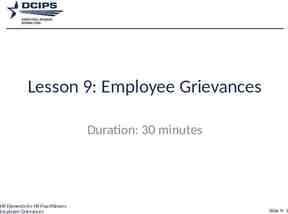State Purchasing Warranties, Indemnification, and Limitation
33 Slides389.89 KB

State Purchasing Warranties, Indemnification, and Limitation of Liability: Oh my!

How does the state seek to mitigate/allocate risk in procurements and resulting contracts? Responsibility/Nonresponsibility determinations Bonding Requirements Insurance Requirements Risk allocation clauses Other ways? 2

Risk Allocation Broadest Sense- Risk allocation is a foundational consideration that exists in every aspect of a relationship, including a contractual relationship Narrow Sense- Risk allocation, or risk allocation clauses, are a narrow set of contractual clauses and devices used to allocate various risks 3

Risk Allocation Contract Provisions Why are provisions addressing risk included in contracts? The State’s Approach and the Supplier’s Approach We will discuss three contract provisions that address risk (there are more). - Warranties - Indemnification - Limitation of Liability * This presentation is for informational purposes. Always consult with your legal counsel regarding issues involving legal liability, such as contract provisions relating to warranties, indemnification, and limitation of liability. 4

5

Addressing Risk What are the State’s concerns when identifying and negotiating risk? What are the Supplier’s concerns and approach regarding risk? -Why is this important? Who is in the best position to address, mitigate, or cover a particular risk? 6

The State’s Approach Standard Terms and Conditions that can be modified by your legal team Analyze Risks - Before you can analyze the impact of a risk allocation device, you must understand the “real-world” risks involved in a transaction! - If you have not evaluated the risks involved in a transaction, you are wasting your time reviewing, negotiating, or drafting risk allocation clauses. Build risk analysis into your acquisition process Sit down with the responsible program manager, or the person that will have to clean up the mess and/or answer for failures - Identify the risks (what could happen that would cause injury to someone) - Identify who would get hurt (agency, other contractor, public, employee) - Identify who would be responsible / liable under the law (data breach notification) - Identify the degree of injury for each risk (what damages would ensue) - Identify the likelihood of each risk (low risk of massive loss, high risk of minimal loss, other?) - Is their data going to be all over the internet if there is a breach? - What is the sensitivity of that data? -If the plumber does not perform or misperforms what are the possible7 consequences?

The Supplier’s Approach - Motivations The obvious – maximize return by minimizing risk The not-so-obvious - Revenue Recognition (next slide) - Responding to - Background Legal Landscape (covered below) - Legal Limits on Limiting Remedies & Liability - Can you think of others?

The Supplier’s Approach - Motivations Revenue Recognition - “An accounting principle under generally accepted accounting principles (GAAP) that determines the specific conditions under which income becomes realized as revenue. Generally, revenue is recognized only when a specific critical event has occurred and the amount of revenue is measurable.” (from investopedia.com) Deferred Revenue - Promises to defend against intellectual property claims - Warranty obligations - Creates a significant impediment to changing warranties in some circumstances - Maintenance Obligations - telephone support / patches / fixes for bugs

The Supplier’s Approach - Motivations Responding to Legal Limits - Court Often Resistance to Limits - Public policy, sense of justice, consumers, unfair bargaining power, use of small-text “boilerplate” - Unconscionability (UCC 2-302(1) & Common Law) - Ambiguity in Concepts - What are “consequential damages” - Failure of Essential Purpose - UCC 2-719(2) “Where circumstances cause an exclusive or limited remedy to fail of its essential purpose, remedy may be had as provided in this Act.”

Risk Analysis Plumbing Buses Janitorial Services Tests/Examinations Tractors Tires Software 11

Risk Allocation- Common Clauses & Devices Warranty Provisions - Warranties are generally promises concerning the quality or performance of goods or services being procured or that a certain fact regarding the subject matter of a contract is, or will be, true Indemnification Provisions- A contractual transfer of risk between two contractual parties generally to prevent loss or compensate for a loss which may occur as a result of a specific event. Limitations of liability - A limitation of liability clause is a provision in a contract that limits the amount of exposure a party faces in the event a lawsuit is filed or another claim is made. If found to be enforceable, a limitation of liability clause can “cap” the amount of potential damages to which a party (typically the contractor) is exposed. - LOL can be located anywhere, though Be on the Lookout For Conditions precedent -a fact other than mere lapse of time which must exist or occur before a duty of immediate performance of a promise arises Eg: Notification required within a specific period of time or obligation ceases Disclaimer -repudiation of an underlying obligation Waiver -intentional relinquishment of a known right Limitations of remedies -only remedy is repair, replace, or refund 12

Represent and Warrant Nonconforming Goods Warranty of Merchantability Warranties! Fitness for a Particular Use Express or Implied 13

What is a Warranty? - Warranties are generally promises concerning the quality or performance of goods or services being procured or that a certain fact regarding the subject matter of a contract is, or will be, true. - Some warranties are provided under law. - Some warranties are provided under contract (part of the deal that is made by the supplier and purchaser). 14

Express Warranty vs. Implied Warranty An express warranty is one that is clearly stated (or “expressed”) either verbally or in writing An implied warranty automatically covers, but only provides a base level of protection 15

Implied Warranty Example: Fitness for a Particular Purpose § 11-2-315. Implied warranty: fitness for particular purpose Where the seller at the time of contracting has reason to know any particular purpose for which the goods are required and that the buyer is relying on the seller's skill or judgment to select or furnish suitable goods, there is unless excluded or modified under Code Section 11-2-316 an implied warranty that the goods shall be fit for such purpose. 16

Express Warranty Example From the Standard State Contract for procurement of Goods and Services: Warranty – Nonconforming Goods. All goods delivered by Contractor to the State Entity shall be free from any defects in design, material, or workmanship. If any goods offered by the Contractor are found to be defective in material or workmanship, or do not conform to Contractor’s warranty, the State Entity shall have the option of returning, repairing, or replacing the defective goods at Contractor’s expense. Payment for goods shall not constitute acceptance. Acceptance by the State Entity shall not relieve the Contractor of its warranty or any other obligation under the Contract. 17

Why do we include warranty provisions in contracts? - To apportion risk and liability between the contractor and the procuring entity. - Warranties provide the buyer with a claim against the seller if the warranty is breached. 18

Risk Warranties - Supplier’s Approach -Provide a narrowly defined warranty (perform according to the specs, be up for a period of time,etc.) -Disclaim all other warranties -Provide a limited remedy Why are they taking this position? - Agency Considerations: What is the risk and what are the consequences? - Operationally, how would this impact us? - Re-procurement? - Cost-wise, can/should we absorb losses or additional supplier cost? Identify impact throughout the contract Do the supplier’s revisions allow for an adequate remedy for the state? What does the marketplace indicate is typical for this type of transaction? What is reasonable? 19

Express Warranty Example From the Standard State Contract for procurement of Goods and Services: Warranty – Nonconforming Goods. All goods delivered by Contractor to the State Entity shall be free from any defects in design, material, or workmanship. If any goods offered by the Contractor are found to be defective in material or workmanship, or do not conform to Contractor’s warranty, the State Entity shall have the option of returning, repairing, or replacing the defective goods at Contractor’s expense. Payment for goods shall not constitute acceptance. Acceptance by the State Entity shall not relieve the Contractor of its warranty or any other obligation under the Contract. 20

Duty to Defend Hold Harmless Save, protect, and defend Negligence Indemnification! Strict Product Liability Indemnify Save Harmless 21

Indemnification An indemnity clause is a contractual transfer of risk between two contractual parties generally to prevent loss or compensate for a loss which may occur as a result of a specific event. 22

Indemnification Common types of losses subject to contractual indemnification: - Breach of warranty by the indemnitor - Breach of other contractual obligations - Violations of law - Losses incurred by the indemnitee due to third party claims - May be general or may specify third party claims against the indemnitee for specific subject matter such as claims of infringement or misappropriation of intellectual property, use of goods by the indemnitee, product defect or liability claims, or claims arising out of death or personal injury 23

Language from the Statewide Contract Contractor's Indemnification Obligation. The Contractor agrees to indemnify and hold harmless the State and State officers, employees, agents, and volunteers (collectively, "Indemnified Parties") from any and all costs, expenses, losses, claims, damages, liabilities, settlements and judgments, including reasonable value of the time spent by the Attorney General’s Office , related to or arising from: (i) Any breach of the Contract; (ii) Any negligent, intentional or wrongful act or omission of the Contractor or any employee, agent or subcontractor utilized or employed by the Contractor; (iii) Any failure of goods to comply with applicable specifications, warranties, and certifications under the Contract; (iv) The negligence or fault of the Contractor in design, testing, development, manufacture, or otherwise with respect to the goods or any parts thereof provided under the Contract; (v) Claims, demands, or lawsuits that, with respect to the goods or any parts thereof, allege product liability, strict product liability, or any variation thereof; (vi) The Contractor’s performance or attempted performance of the Contract, including any employee, agent or subcontractor utilized or employed by the Contractor; (vii) Any failure by the Contractor to comply with the "Compliance with the Law" provision of the Contract; (viii) Any failure by the Contractor to make all reports, payments and withholdings required by federal and state law with respect to social security, employee income and other taxes, fees or costs required by the Contractor to conduct business in the State of Georgia or the United States; (ix) Any infringement of any copyright, trademark, patent, trade dress, or other intellectual property right; or (x) Any failure by the Contractor to adhere to the confidentiality provisions of the Contract. 24

Why are indemnification provisions included in contracts? - Shifts burden of loss - Compensating an indemnified party for: - Risks it did not assume; and - Expenses that may not be recoverable under common law - Shifts the cost of defending third-party claims *Remember that the State cannot agree to certain contractual provisions relating to indemnification 25

Supplier’s Approach Narrowly tailor the indemnification clause -“Willful Misconduct” and “Gross Negligence” standards -Limiting the scope of the Indemnity -Limiting circumstances for which indemnification is available -Eg: A judgment against contractor is required -Capping dollar amount for indemnification obligation -Requiring that Contractor select counsel and lead the defense - - Agency Approach What is the risk and what are the consequences? - Operationally, how would this impact us? - Reprocurement? - Cost-wise, can/should we absorb losses or additional supplier cost? Identify impact throughout the contract Do the supplier’s revisions allow for an adequate remedy for the state? What does the marketplace indicate is typical for this type of transaction? 26 What is reasonable?

Direct Damages Consequential Damages Third Party Claims Limitation of Liability Special Damages Indirect Damages 27

Why are limitation of liability provisions included in contracts? Limitation of liability provisions attempt to place a limit on the amount of damages that a party can recover in the event a lawsuit is filed or another claim is made. If found to be enforceable, this clause can limit the amount of damages that can be covered, as well as the type. The limit may apply to all claims arising during the course of the contract, or it may apply only to certain types of causes of action. Limitation of liability clauses typically limit the liability to one of the following amounts (i) the compensation and fees paid under the contract; (ii) an agreed upon amount of money; (iii) available insurance coverage; or (iv) a combination of two or more above. 28

Example from State Standard Contract for Goods and Services Limitation of Contractor’s Liability to the State. Except as otherwise provided in this Contract, Contractor’s liability to the State for any claim of damages arising out of this Contract shall be limited to direct damages and shall not exceed the total amount paid to Contractor for the performance under this Contract. No limitation of Contractor's liability shall apply to Contractor's liability for loss or damage to State equipment or other property while such equipment or other property is in the sole care, custody, and control of Contractor's personnel. Contractor hereby expressly agrees to assume all risk of loss or damage to any such State equipment or other property in the care, custody, and control of Contractor's personnel. Contractor further agrees that equipment transported by Contractor personnel in a vehicle belonging to Contractor (including any vehicle rented or leased by Contractor or Contractor's personnel) shall be deemed to be in the sole care, custody, and control of Contractor's personnel while being transported. Nothing in this section shall limit or affect Contractor's liability arising from claims brought by any third party. Agencies should consider revisions to this provision based on the goods/services being procured! -What are the consequences of unlimited liability? 29

Supplier’s Approach -Limit categories of damages that can be awarded. -Provide discretion to supplier regarding specific remedies (eg: supplier can choose repair or replace) -Cap Liabilty - - Agency Approach What is the risk and what are the consequences? - Operationally, how would this impact us? - Reprocurement? - Cost-wise, can/should we absorb losses or additional supplier cost? Identify impact throughout the contract Do the supplier’s revisions allow for an adequate remedy for the state? What does the marketplace indicate is typical for this type of transaction? What is reasonable? 30

Limitation of Liability Warranty Indemnification -Warranties, Indemnification provisions, and Limitation of Liability provisions are interrelated -Modifications to one provision can impact the other provisions 31

Overview of Supplier’s Approach Layering into the contract various devices to avoid risk -drafting a variety of fallback protections – as one fails, the other remains Limited Warranty Provide a Warranty Narrowly Defined the Warranty (perform according to specs; be up for a period of time) Exclude Any Other Warranties – including express or any implied by law Exclusive Remedy Grant a Narrow Remedy Make Remedy Exclusive “[R]esort to a remedy as provided is optional unless the remedy is expressly agreed to be exclusive, in which case it is the sole remedy.” UCC 2-719(1)(b) Avoid Certain Possible Remedies Right to Cover & Recover Cost of Cover Rejection of Non Conforming Goods Cap Liability (Liability Cap) Exclude Categories of Damages (w/in liability cap) Damages Exclusion by category Consequential Damages Waiver Narrowly Stated Performance Obligations Broadened & Express Contractee’s Obligation 32

Name of Presenter phone Email or website






